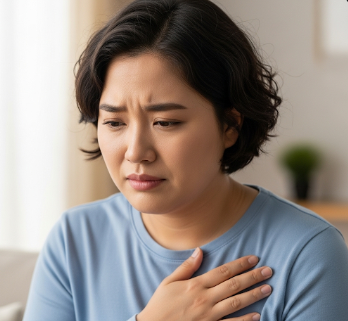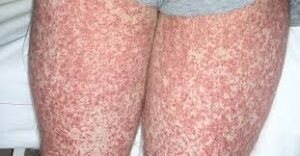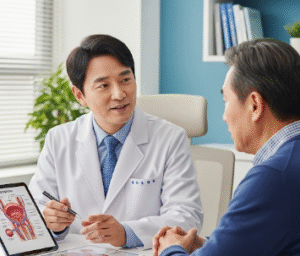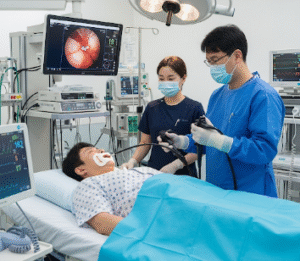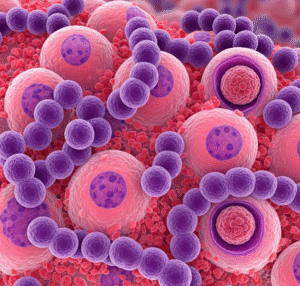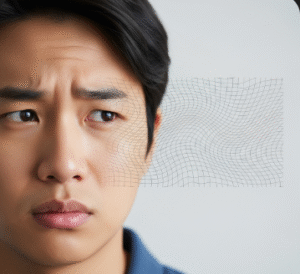➤ Overview
Sore nipples refer to discomfort, tenderness, or pain in the nipple area, which can affect both men and women. This condition can range from mild sensitivity to severe pain and may be temporary or chronic.
In South Korea, sore nipples are evaluated by primary care physicians, gynecologists, lactation consultants, and dermatologists. Understanding the underlying causes, risk factors, and appropriate treatments is essential to relieve discomfort, prevent complications, and maintain breast health.
➤ Key Facts
→ Sore nipples can affect one or both nipples, depending on the cause.
→ Causes can be physiological, hormonal, mechanical, or infectious.
→ Common triggers include breastfeeding, hormonal changes, friction from clothing, or infections.
→ Persistent soreness may indicate underlying conditions such as dermatitis, mastitis, or, rarely, breast cancer.
→ In Korea, lactation support, topical treatments, and medical evaluation are commonly available.
→ Proper care prevents cracks, infections, or worsening pain.
→ Sore nipples are common in puberty, pregnancy, lactation, and hormonal cycles.
➤ What is Sore Nipples?
Sore nipples are a localized pain or tenderness in the nipple area, often accompanied by other symptoms depending on the cause:
→ Breastfeeding-related soreness – Cracks or irritation from improper latch or frequent nursing.
→ Hormonal changes – Puberty, menstruation, pregnancy, or menopause can cause cyclical nipple sensitivity.
→ Mechanical irritation – Friction from tight clothing, sports bras, or exercise.
→ Infections or skin conditions – Bacterial, fungal, or dermatologic causes.
→ Medical conditions – Rarely, underlying breast pathology such as eczema, mastitis, or Paget’s disease.
Korean healthcare providers assess medical history, breastfeeding habits, and skin condition to determine the underlying cause and guide treatment.
➤ What Symptoms are Related to Sore Nipples?
Sore nipples may present with additional symptoms that help identify the cause:
→ Pain, tenderness, or burning sensation in one or both nipples.
→ Cracks, fissures, or bleeding, especially in breastfeeding women.
→ Redness, swelling, or warmth in the surrounding breast tissue.
→ Itching or irritation due to dermatitis or fungal infection.
→ Discharge from the nipple – clear, milky, or blood-tinged.
→ Pain during sexual activity or clothing contact.
→ Cyclic pain coinciding with menstrual cycles or hormonal changes.
→ Thickened skin or visible changes in rare underlying breast conditions.
➤ What Causes / Possible Causes?
Sore nipples can arise from various physiological, mechanical, hormonal, and pathological factors:
→ Breastfeeding complications – Poor latch, frequent nursing, or cracked nipples.
→ Hormonal changes – Puberty, menstrual cycle, pregnancy, or menopause.
→ Friction or irritation – Tight clothing, bras, exercise, or trauma.
→ Infections – Bacterial (mastitis), fungal (Candida), or viral infections.
→ Dermatologic conditions – Eczema, psoriasis, or contact dermatitis.
→ Allergic reactions – Skincare products, detergents, or fabrics.
→ Medical conditions – Rarely, Paget’s disease of the breast, tumors, or nipple dermatitis.
→ Medications – Certain drugs may increase nipple sensitivity.
➤ When Should I See My Doctor?
Medical consultation is necessary if sore nipples are persistent, severe, or associated with other concerning symptoms:
→ Pain lasting more than two weeks without improvement.
→ Cracks, bleeding, or discharge from the nipple.
→ Redness, swelling, or warmth indicating infection or inflammation.
→ Pain associated with a lump in the breast or skin changes.
→ Fever or systemic symptoms suggesting mastitis or other infections.
→ Recurring pain despite proper breastfeeding technique or lifestyle modifications.
→ Any nipple changes in men or non-lactating women requiring evaluation.
➤ Care and Treatment
Management of sore nipples focuses on relieving pain, promoting healing, and addressing the underlying cause:
→ Breastfeeding support – Proper latch, frequency, and positioning guidance.
→ Topical treatments – Lanolin creams, medicated ointments, or antifungal creams if indicated.
→ Pain relief – Warm compresses, cold packs, or analgesics for temporary comfort.
→ Proper clothing – Soft, non-restrictive bras to reduce friction.
→ Hygiene measures – Gentle washing, avoiding harsh soaps, and keeping the area dry.
→ Treatment of infections – Antibiotics or antifungals for bacterial or fungal causes.
→ Hormonal and lifestyle adjustments – Managing cyclic pain or irritation triggers.
→ Medical interventions – For persistent or suspicious cases, biopsy or further evaluation may be required.
➤ Treatment Options in Korea
South Korea offers comprehensive care for sore nipples, integrating medical evaluation, lactation support, and dermatologic care:
Diagnosis in Korea
→ Detailed clinical assessment by gynecologists, dermatologists, or lactation specialists.
→ Laboratory tests or cultures for bacterial or fungal infections.
→ Imaging or biopsy if underlying breast pathology is suspected.
Medical Treatments in Korea
→ Prescription topical creams for infections, inflammation, or dermatitis.
→ Analgesics or anti-inflammatory medications for pain relief.
→ Guidance on breastfeeding techniques, hygiene, and protective measures.
Advanced Therapies in Korea
→ Laser therapy or dermatologic procedures for chronic nipple skin conditions.
→ Integrative approaches combining Western medicine and Korean traditional therapies for healing and comfort.
→ Professional lactation consultations for persistent breastfeeding-related soreness.
Rehabilitation & Support in Korea
→ Education on nipple care, breastfeeding practices, and hygiene.
→ Follow-up to monitor healing and prevent recurrence.
→ Support for psychological comfort and confidence, particularly for breastfeeding mothers.

